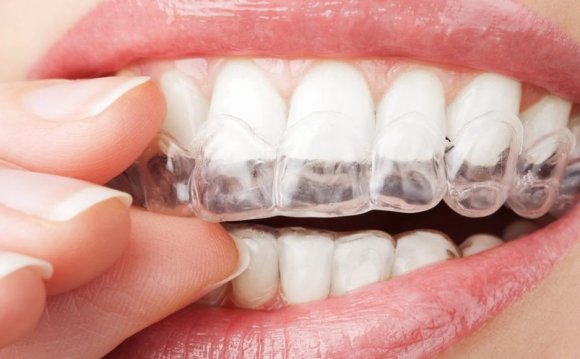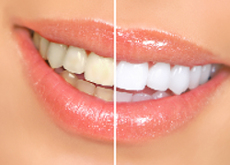
 Authored By: Linda Dyett
Authored By: Linda Dyett
Reviewed By: Larry Addleson, DDS, FAACD
Are you looking for a quick, non-invasive way to enhance your smile? Teeth whitening might be the answer.
Universally valued by men and women alike, teeth whitening (or bleaching) treatments are available to satisfy every budget, time frame and temperament. Whether in the form of one-hour bleaching sessions at your dentist's office, or home-use bleaching kits purchased at your local drugstore, teeth whitening solutions abound.
The long and the short of it is that teeth whitening works. Virtually everyone who opts for a teeth whitening solution sees moderate to substantial improvement in the brightness and whiteness of their smile. That said, whitening is not a permanent solution to discoloration and requires maintenance or "touch-ups" for a prolonged effect.
Bleaching vs. Whitening: What's the Difference?
According to the FDA, the term "bleaching" is permitted to be used only when the teeth can be whitened beyond their natural color. This applies strictly to products that contain bleach typically hydrogen peroxide or carbamide peroxide.
The term "whitening, " on the other hand, refers to restoring a tooth's surface color by removing dirt and debris. So any product that cleans (like a toothpaste) is technically considered a whitener. Of course, the term whitening sounds better than bleaching, so it is more frequently used even when describing products that contain bleach.
Why Teeth Whitening? Examining Enamel
Most of us start out with sparkling white teeth, thanks to their porcelain-like enamel surface. Composed of microscopic crystalline rods, tooth enamel is designed to protect the teeth from the effects of chewing, gnashing, trauma and acid attacks caused by sugar. But over the years enamel is worn down, becoming more transparent and permitting the yellow color of dentin the tooth's core material to show through.
During routine chewing, dentin remains intact while millions of micro-cracks occur in the enamel. It is these cracks, as well as the spaces between the crystalline enamel rods, that gradually fill up with stains and debris. As a result, the teeth eventually develop a dull, lackluster appearance.
Teeth whitening removes the stains and debris, leaving the enamel cracks open and exposed. Some of the cracks are quickly re-mineralized by saliva, while others are filled up again with organic debris.
Tooth Discoloration: The Two Types of Tooth Stains
There are two categories of staining as it relates to the teeth: extrinsic staining and intrinsic staining.
Extrinsic stains are those that appear on the surface of the teeth as a result of exposure to dark-colored beverages, foods and tobacco, and routine wear and tear. Superficial extrinsic stains are minor and can be removed with brushing and prophylactic dental cleaning. Stubborn extrinsic stains can be removed with more involved efforts, like teeth bleaching. Persistent extrinsic stains can penetrate into the dentin and become ingrained if they are not dealt with early.
Intrinsic stains are those that form on the interior of teeth. Intrinsic stains result from trauma, aging, exposure to minerals (like tetracycline) during tooth formation and/or excessive ingestion of fluoride. In the past, it was thought that intrinsic stains were too resistant to be corrected by bleaching. Today, cosmetic dentistry experts believe that even deep-set intrinsic stains can be removed with supervised take-home teeth whitening that is maintained over a matter of months or even a year. If all else fails, there are alternative cosmetic solutions to treat intrinsic staining, such as dental veneers.
Whitening and veneers are two popular smile makeover treatment options. Weigh their pros and cons with your needs.
What Causes Tooth Staining?
Age: There is a direct correlation between tooth color and age. Over the years, teeth darken as a result of wear and tear and stain accumulation. Teenagers will likely experience immediate, dramatic results from whitening. In the twenties, as the teeth begin to show a yellow cast, teeth-whitening may require a little more effort. By the forties, the yellow gives way to brown and more maintenance may be called for. By the fifties, the teeth have absorbed a host of stubborn stains which can prove difficult (but not impossible) to remove.
Starting color: We are all equipped with an inborn tooth color that ranges from yellow-brownish to greenish-grey, and intensifies over time. Yellow-brown is generally more responsive to bleaching than green-grey.
Translucency and thinness: These are also genetic traits that become more pronounced with age. While all teeth show some translucency, those that are opaque and thick have an advantage: they appear lighter in color, show more sparkle and are responsive to bleaching. Teeth that are thinner and more transparent most notably the front teeth have less of the pigment that is necessary for bleaching. According to cosmetic dentists, transparency is the only condition that cannot be corrected by any form of teeth whitening.
Eating habits: The habitual consumption of red wine, coffee, tea, cola, carrots, oranges and other deeply-colored beverages and foods causes considerable staining over the years. In addition, acidic foods such as citrus fruits and vinegar contribute to enamel erosion. As a result, the surface becomes more transparent and more of the yellow-colored dentin shows through.
Smoking habits: Nicotine leaves brownish deposits which slowly soak into the tooth structure and cause intrinsic discoloration.
Drugs / chemicals: Tetracycline usage during tooth formation produces dark grey or brown ribbon stains which are very difficult to remove. Excessive consumption of fluoride causes fluorosis and associated areas of white mottling.
Grinding: Most frequently caused by stress, teeth grinding (gnashing, bruxing, etc.) can add to micro-cracking in the teeth and can cause the biting edges to darken.
Trauma: Falls and other injuries can produce sizable cracks in the teeth, which collect large amounts of stains and debris.
Teeth Whitening Options
Three major teeth whitening options are available today. All three rely on varying concentrations of peroxide and varying application times.









